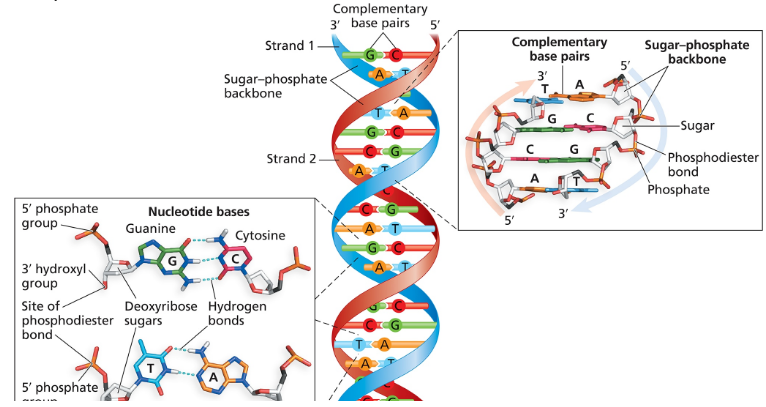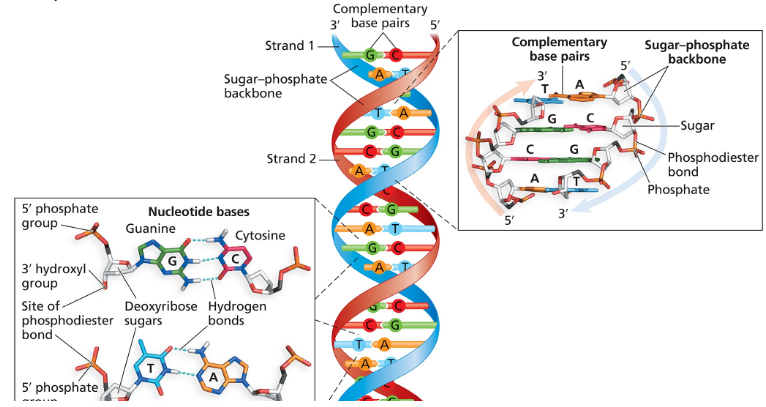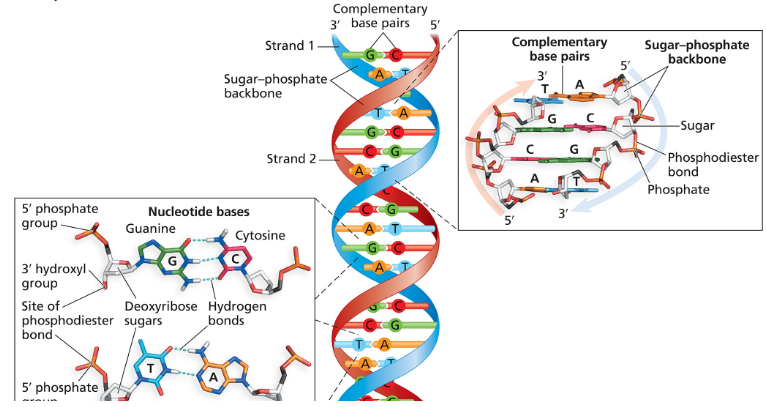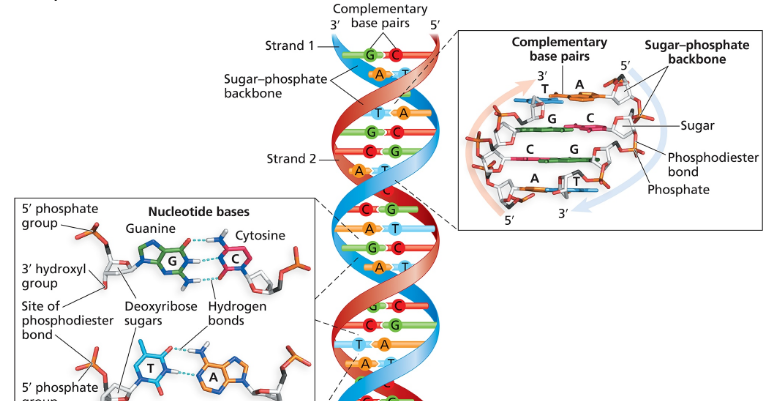 Back
BackProblem 5h
One strand of a fragment of duplex DNA has the sequence 5'-ATCGACCTGATC-3'.
What term is used to describe the pattern of base pairing between one DNA strand and its partner in a duplex?
Problem 5i
One strand of a fragment of duplex DNA has the sequence 5'-ATCGACCTGATC-3'.
What term is used to describe the polarity of two DNA strands in a duplex?
Problem 6
The principles of complementary base pairing and antiparallel polarity of nucleic acid strands in a duplex are universal for the formation of nucleic acid duplexes. What is the chemical basis for this universality?
Problem 7
For the following fragment of DNA, determine the number of hydrogen bonds and the number of phosphodiester bonds present:
5'-ACGTAGAGTGCTC-3'
3'-TGCATCTCACGAG-5'
Problem 8a
The following figure (Figure 1.6) presents simplified depictions of nucleotides containing deoxyribose, a nucleotide base, and a phosphate group. Use this simplified method of representation to illustrate the sequence 3'-AGTCGAT-5' and its complementary partner in a DNA duplex.
What kind of bond joins the C to G within a single strand?
Problem 8b
The following figure (Figure 1.6) presents simplified depictions of nucleotides containing deoxyribose, a nucleotide base, and a phosphate group. Use this simplified method of representation to illustrate the sequence 3'-AGTCGAT-5' and its complementary partner in a DNA duplex.
What kind of bonds join the C in one strand to the G in the complementary strand?
Problem 8c
The following figure (Figure 1.6) presents simplified depictions of nucleotides containing deoxyribose, a nucleotide base, and a phosphate group. Use this simplified method of representation to illustrate the sequence 3'-AGTCGAT-5' and its complementary partner in a DNA duplex.
How many phosphodiester bonds are present in this DNA duplex?
Problem 8d
The following figure (Figure 1.6) presents simplified depictions of nucleotides containing deoxyribose, a nucleotide base, and a phosphate group. Use this simplified method of representation to illustrate the sequence 3'-AGTCGAT-5' and its complementary partner in a DNA duplex.
How many hydrogen bonds are present in this DNA duplex?
Problem 9a
Consider the sequence 3'-ACGCTACGTC-5'.
What is the double-stranded sequence?
Problem 9b
Consider the sequence 3'-ACGCTACGTC-5'.
What is the total number of covalent bonds joining the nucleotides in each strand?
Problem 9c
Consider the sequence 3'-ACGCTACGTC-5'.
What is the total number of noncovalent bonds joining the nucleotides of the complementary strands?
Problem 10
DNA polymerase III is the main DNA-synthesizing enzyme in bacteria. Describe how it carries out its role of elongating a strand of DNA.
Problem 11a
There is a problem completing the replication of linear chromosomes at their ends. Describe the problem and identify why telomeres shorten in each replication cycle.
Problem 11b
There is a problem completing the replication of linear chromosomes at their ends. What is the function of telomerase, and how does it operate to synthesize telomeres?
Problem 12
Explain how RNA participates in DNA replication.
Problem 13
A sample of double-stranded DNA is found to contain 20% cytosine. Determine the percentage of the three other DNA nucleotides in the sample.
Problem 14a
Bacterial DNA polymerase I and DNA polymerase III perform different functions during DNA replication.
Identify the principal functions of each molecule.
Problem 14b
Bacterial DNA polymerase I and DNA polymerase III perform different functions during DNA replication.
If mutation inactivated DNA polymerase I in a strain of E. coli, would the cell be able to replicate its DNA? If so, what kind of abnormalities would you expect to find in the cell?
Problem 14c
Bacterial DNA polymerase I and DNA polymerase III perform different functions during DNA replication.
If a strain of E. coli acquired a mutation that inactivated DNA polymerase III function, would the cell be able to replicate its DNA? Why or why not?
Problem 15
Diagram a replication fork in bacterial DNA and label the following structures or molecules.
a. DNA pol III
b. Helicase
c. RNA primer
d. Origin of replication
e. leading strand (label its polarity)
f. DNA pol I
g. Topoisomerase
h. SSB protein
i. Lagging strand (label its polarity)
j. Primase
k. Okazaki fragment
Problem 16a
Which of the following equations are true for the percentages of nucleotides in double-stranded DNA?
(A + G)/(C + T)= 1.0
Problem 16b
Which of the following equations are true for the percentages of nucleotides in double-stranded DNA?
(A + T)/(G + C)= 1.0
Problem 16c
Which of the following equations are true for the percentages of nucleotides in double-stranded DNA?
(A)/(T) = (G)/(C)
Problem 16d
Which of the following equations are true for the percentages of nucleotides in double-stranded DNA?
(A)/(C) = (G)/(T)
Problem 16e
Which of the following equations are true for the percentages of nucleotides in double-stranded DNA?
(A)/(G) = (T)(C)
Problem 17a
Which of the following equalities is not true for double-stranded DNA?
(G + T) = (A + C)
Problem 17b
Which of the following equalities is not true for double-stranded DNA?
(G + C) = (A + T)
Problem 17c
Which of the following equalities is not true for double-stranded DNA?
(G + A) = (C + T)
Problem 18
List the order in which the following proteins and enzymes are active in E. coli DNA replication: DNA pol I, SSB, ligase, helicase, DNA pol III, and primase.
Problem 19
Two viral genomes are sequenced, and the following percentages of nucleotides are identified:
Genome 1: A = 28%, C = 22%, G = 28%, T = 22%
Genome 2: A = 22%, C = 28%, G = 28%, T = 22%
Are the DNA molecules in each genome single-stranded or double-stranded?




